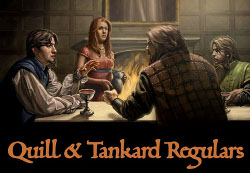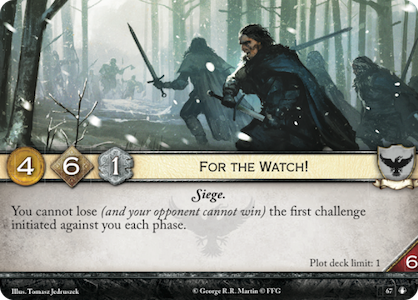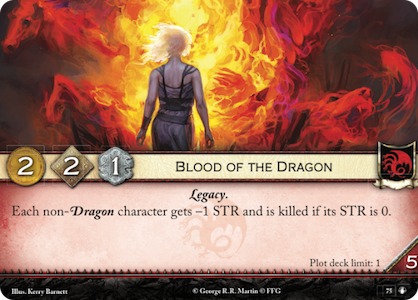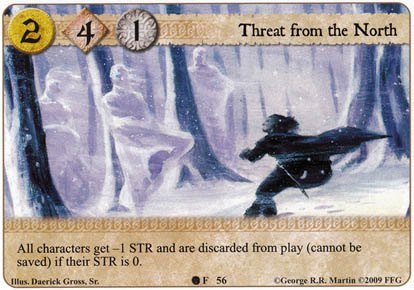Welcome to Card Game DB
Register now to gain access to all of our features. Once registered and logged in, you will be able to create topics, post replies to existing threads, give reputation to your fellow members, get your own private messenger, post status updates, manage your profile and so much more. If you already have an account, login here - otherwise create an account for free today!
Register now to gain access to all of our features. Once registered and logged in, you will be able to create topics, post replies to existing threads, give reputation to your fellow members, get your own private messenger, post status updates, manage your profile and so much more. If you already have an account, login here - otherwise create an account for free today!
Quill & Tankard Regulars - Volume 2, Issue 8
Mar 06 2016 06:00 PM |
WWDrakey
in Game of Thrones
WWDrakey Istaril JCWamma Ire Ratatoskr Quill & Tankard Regulars - Volume 2, Issue 8
Quill & Tankard Regulars - Volume 2, Issue 8It did not take long to realize that they should have tried the device out somewhere else than in the empty Quill & Tankard taproom. Honestly, anywhere else would have been better.
The first hint should have been the shady merchant, or the shop’s seedy location. If not that, then the acrid smell of all the various powders should have given warning enough. Or perhaps just the old Valyrian instructions indicating what to set fire to. Or just the words “set fireâ€, really...
Yet, here it was. Spinning around, throwing sporadic spouts of flame here and there. Clattering and bouncing around the floor. Crashing into bottles on tables and upending chairs.
Somewhere from behind a hastily cobbled together table-turned-bunker a low-pitched voice was... calmly stating something.
“In my defense, I told you that the merchant warned about mistreating the device. It was you that insisted that it cannot do anything bad, looking so ridiculous!â€
The Bad Side of Oldtown: Unintuitive Interactions, pt. I
There is a side to Oldtown, where only the suicidal and morbid dare to tread, where the streets form a labyrinth, and even fervent Archmaesters hold tightly to their Valyrian Steel Links. This is where the rules can twist into surprising shapes, or terrible spectres. This is the Bad Side of Oldtown.
The Bad Side of Oldtown is a classic Q&TR portion back from the first edition of the game, where we detailed all kinds of exceedingly peculiar rules interactions that had arisen in the large cardpool. Back in the day, it featured everything from being able to give traits to events after playing them (here, later errata’d to be impossible) and Walder Frey being so Deadly he would end up killing himself (here, a classic) to Immunity not quite being as encompassing as people thought (here, relevant with the Seastone Chair) and even fast-forwarding actions in play etiquette (here). As can be seen, the Bad Side of Oldtown has always concentrated on the unintuitive and messy.
With 2nd Edition now being in the halfway point of its first Cycle, it felt like a good time to resurrect the Bad Side to do a bit of a roundup on what seemingly unintuitive rulings and behaviour the 2nd Edition of the game has managed to stumble into, despite better templating and clearer rules being some of its stated goals.
With just the cards from the Core Set, we ran into the following kinds of curious surprises:
Hand’s Judgement & X - The first and most obvious one, that people soon ran into after the Core Set was released, was that cancelling an event with a cost of X with Hand’s Judgement always costs nothing, as Hand’s Judgement refers to printed cost. So, in a competition of Hand’s Judgements, the amount of gold is not a factor. For more info, see here.
Catelyn Stark & Game effects, Duplicates, Constant effects… - Another card that immediately raised questions was Catelyn Stark. In fact, she was the first card to get a rules question on the cardgamedb rules forum (ok, by the moderator himself, as an example question, but still!). One reason here is that Catelyn works very differently from the Brienne of Tarth many 1.0 players were used to. How so? Well, firstly she doesn’t prevent the usage of duplicates, as she only works on card abilities, and those are now game abilities. She also doesn't stop Forced abilities, as those aren't actually initiated by players but by the game (that's why the FP gets to determine the order!). However, much like Brienne, she also only cares about triggered effects, so she does not affect constant effects or keywords in any way. Euron Crow's Eye still gets to Pillage all he wants, but he just can’t grab that Kingsroad back... Her effect does still prevent usage of several key effects, like Bodyguards, Tears of Lys, or cancels to your own Tears, and she can even push through plots like King’s Peace or stop Rise of the Kraken from being triggered. For more info, see here.
Marching Orders & Ambush - Marching Orders has an interestingly specific restriction on marshaling (only), which means a few things. Firstly, anything can still be put into play with the Ambush keyword, so Widow’s Wail and Practice Blade are very much still playable. Additionally, if we get non-character cards with similar effects to Ser Alliser Thorne (putting a card into play without playing or marshalling it), they will all work around Marching Orders as well.
Melee & Redirect, Eddard Stark - Naturally Melee also brought its own complexities to the game. The redirection from The Crown Regent and its interactions with both Supporting (a Redirected Challenge can go against a Supported player) and cards like Eddard Stark (Eddard doesn’t stand when the challenge is only redirected against you) being some of the more often seen. For more info, see here.
Considering the number of distinct cards in the Core Set, the truly problematic situations have been few and far between. Of course, new cards arriving in Chapter Packs have also contributed their own fair share of interactions...
Nymeria & Icons - Nymeria doesn’t really care whether her target actually has an icon of the chosen kind to steal. She’ll happily gain her icon anyway, making her a functional tricon, similarily to Unsworn Apprentice… as long as your opponent controls a character, that is! Of course, if the character were to gain an extra icon after Nymeria’s effect is triggered, it would immediately disappear, as the effect is still very much in place. Food for thought for Ser Alliser Thorne & Practice Blade. For more info, see here.
Brothel Madame & multiples, A Meager Contribution - The wording on Brothel Madame is a bit interesting, in that multiple Madame’s don’t play nice in Joust. All it takes is to give gold once to stop the effect of all of them. Think of it as a Season's Pass to all of Littlefinger’s establishments? Of course one needs to also be careful with the verb in question. Some card effects, like A Meager Contribution, seem to use the verb “moveâ€, while Brothel Madame only cares about the verb “giveâ€. So, while the two do not interact due to being limited to different phases, it does not take much imagination to picture future effects having curious interactions with the Madame. For some discussion, see here.
Tears of Lys & Immunity to Events - With Immune to Events appearing in the game after A Tourney for the King came out, there was even a bit of a ruckus (with Istaril & Ktom disagreeing!) over on the FFG Boards on how Tears of Lys delayed effect interacted with said Immunity. In this case, all’s well that ends in a well, and the Knights are hard to poison during Tourneys. Likely due to all the beer magically counteracting the effects of the poison?
Winterfell Kennel Master & Stealth - Stealth talks about “declaring†as a defender. Winterfell Kennel Master works around that, as the character is not declared. Simple, really. For a discussion regarding this, see here.
Mostly, while the rulings may be unintuitive, they're quite well supported by the documentation... so far. That said, new cards will always bring new complex interactions with them, and there will always be a need for visits to the Bad Side of Oldtown.
Reminder: A good resource for common unintuitive rules interactions is The Unofficial Rules FAQ.
The Raven’s Message
The Raven’s Message exclusively reveals and discusses an up-and-coming, either mechanically or rules-wise interesting, card. The cards are from future products, and have been obtained directly via raven from the Archmaesters at the (FFG) Citadel.
Today we’ll be bringing you two faction-specific plots from the upcoming No Middle Ground chapter pack - one you may have seen before, and one you will be rejoicing/cursing to see again…

The first card, For The Watch!, was already spoiled in the FFG article for this cycle, but as an amouse-bouche to our main spoiler, we will be looking at what it means, both for rules gurus and for Night's Watch decks.
Firstly, the rules implications. As a general rule, the word "Cannot" is absolute. This is not relevant... yet, but if we get a card that allows you to automatically win a challenge (for instance, the 1.0 Misinformation event), this could not override it. You simply cannot lose that challenge.
But what does that actually mean? Well, aside from win/loss triggers, claim and keywords, you also cannot give up an unopposed challenge if the opponent didn't actually win it. This gives the effect a very obvious synergy with The Wall. Of course that does not mean you automatically win the challenge, only that when you otherwise would lose it, you do not. So, no free Shadowblack Lane triggers without actually defending. However, if you do want to win it, you can do so by declaring defenders as usual. Given the opponent is likely to not commit much, a good opportunity to win by 5 on defense will oft present itself - making this plot a real boon for an effect like The Sword in the Darkness.
There's one other trick here in Melee, with the Crown Regent title - as discussed in the "Badside of Oldtown" section above, a challenge that has been redirected to you has not been initiated against you. This means that, with this plot revealed, you can lose a challenge redirected to you, even if it's the first challenge you have to defend that phase. One somewhat less obvious part concerns the reverse - a challenge initiated against you that is then redirected. Even though the card specifies "your opponent cannot win the first challenge initiated against you", a challenge initiated against you but redirected away CAN be won by the attacker. This is because, by being italicised, the "(and your opponent cannot win)" text is not rules text, but only clarification - clarification text, that in this instance could prove misleading.
One final trick to this card concerns a somewhat innocent couple of words in the current game, that could prove important later - "each phase". This means that, should we gain the ability to challenge in different phases (which we had in 1.0), For the Watch! will work once for each phase, giving it a potentially huge power upgrade.
But what about the here and now? Well there's the obvious - a boost for Night's Watch defence decks, as their opponent has to expend extra energy to get to a challenge they can win at all, much less win unopposed and trigger the Wall. As mentioned above the ability to win by 5 on defence and trigger A Sword in the Darkness also pushes NW defence. Somewhat less-obviously, this is a huge boon for NW Aggro decks. Pushing challenges usually leaves oneself open for a counter attack. With For the Watch!, you can push just that little bit harder on attack, knowing the recriminations can't be as fierce as they might otherwise be.
This plot sits at a curious point in the current meta-game, as The Lord of the Crossing welcomes it from either side of the table. As Crossing tends towards an aggro approach, the Night's Watch Crossing build will make good use of it... however, against opponent's Crossing decks, the plot will lack some of its punch as the challenge the opponent cannot win is the challenge they're already penalised in. Will this plot therefore see an increase in decks running the new agenda? Perhaps, although perhaps that in turn will be offset by the next plot...

There's an awful lot to unpack with Blood of the Dragon, which is an incredibly exciting card, but let's start with the most important - the rules interactions. Some may surprise new and old players alike.
Firstly, the basics - as with other terminal burn effects like Dracarys! and Crown of Gold, the "killed if its STR is 0" effect eats through saves. You can only save from terminal burn if the save also increases the character's STR above 0 - say, for example, Risen from the Sea.
The timing with effects from characters with 1 STR is important to consider also. Firstly, with the concept of moribund confined to first edition, there is no opportunity to react to the playing of a STR 1 character before they die - so your Greenblood Traders will be useless for a round.
A slightly more complex one to unpack is the exact timing of the leaves play effects of a card like, say, Bastard Daughter. If you, a Targaryen Banner of the Sun player, had a Bastard Daughter in play and revealed Blood of the Dragon against Counting Coppers, what order do things happen in? The answer is that, even before when revealed effects, the Bastard Daughter would die - and, as an interrupt, would trigger the random discard... still before when revealed effects. Better hope the opponent wasn't playing Counting Coppers because their hand was empty!
The last, and most difficult question to answer, concerns the timing of stealth. Say you have Arya Stark on the table, and your Targaryen opponent has Blood of the Dragon revealed and Daenerys Targaryen standing. If you declare Arya Stark as an attacker, do you get to choose a target for her Stealth? Either way Arya is dying, but that Stealth could win you the game...
So, what's the answer? Well, truth be told, the powers that be are still debating it (incredibly apt for the return of Bad Side of Oldtown...). So, with this we'll have to leave you on a cliffhanger, and will post the answer as a comment / update once it has been sussed out. Stay tuned!
Before we look at what this card means for the current metagame, it's worthwhile to reflect on its 1.0 predecessor, Threat from the North.

Threat was a significant card in first edition, the centrepiece for most Targaryen decks, and all burn decks. Thematically the card was always 'off' in first edition though - the winter/others theme didn't gel with the burn. Finally in 2.0 we have a version where the theme matches the mechanic! If the Targ faction loyalty didn't clue you in enough, the name of the plot and "non-Dragon" stipulation tells you who owns the STR-reduction concept in second edition.
Mechanically there are two other big differences here - firstly, the card killing rather than discarding. This is a pretty major shift, as it makes it seriously difficult to justify running multiple copies of low-STR uniques - decks trying to include multiples of Edric Dayne, Viserys Targaryen, or perhaps most chillingly Bran Stark will struggle to justify it in this match-up in a way that wasn't problematic in first edition. Secondly, and perhaps reassuringly, the card has lost its "cannot be saved" text, meaning that at least you can deploy Risen from the Sea.
So how does this plot actually factor into the current meta? Its impact likely cannot be overstated. First of all, keeping it in-house, Targaryen gain a lot from the plot. While Viserys may find he's not a true Dragon after all, most of their other cheap characters benefit from high STR - compare Braided Warrior to the likes of Greenblood Trader, Arbor Knight, Lordsport Shipwright or Messenger Raven and it's not hard to see why Targaryen might be able to get some strong use out of this plot. Additionally, not only does it kill off STR 1 characters, but it brings stronger characters into the reach of your burn - a STR 5 character now cannot be risked against Dracarys!, a STR 3 character can be killed with the Plaza of Punishment, and both Daenerys Targaryen and Unsullied have an even greater impact on the board than before.
Targaryen's gain is economy's loss, however. Practically every deck includes as many copies of the 1-cost, 1 STR reducer characters as possible. However, with Blood of the Dragon entering the game, if they can all be mass-killed at the turn of a plot, they become less of a lynchpin. Perhaps the limited economy cards will gain greater preference, or players will just adapt their cost curves - or maybe one must simply take a more cavalier attitude to economy when playing Targaryen.
Another victim of this plot are decks running the Lord of the Crossing agenda. That -1 STR modifier on the first challenge becomes a lot more dangerous when it puts your characters closer to death - and if you cannot get that first challenge off, how do you get the second and third challenges through?
So, if this plot is going to uproot the meta, how can one prepare against it? One option are global STR pumps. The Wall grants +1 STR to all Night's Watch characters, meaning even your Messenger Ravens will be able to survive the Blood of the Dragon round. Additionally, in the upcoming Wolves of the North box, Stark find a similar global STR pump in the form of Winterfell. If these cards become a common theme, perhaps the Blood of the Dragon won't be as powerful as many expect it to be. In the meantime, however...
Antti Korventausta (WWDrakey) is a self-proclaimed Finnish AGoT philosopher and doomsayer hermit, who used to practice Quantum Mechanics, but found that it paled to AGoT in both interest and complexity. Having played and judged for more years than he would like to admit, he has found himself on the winning side of rules arguments more than he would expect. In any game he plays, he has a tendency of playing anything he considers to be off the beaten path, whether it makes sense to others or not.
Helmut Hohberger (Ratatoskr) started playing AGoT in September 2010 and has never looked back (although his wife has, longingly). As a German, he loves rules - and I mean *loves* 'em. He is the quintessential rules board morlock. While the others played and frolicked about outside, he sat by candlelight in a remote corner of the library and tried to get a grasp on the intricacies of the 1st edition rules. He even thought he did not do too bad at it, but then the Call of the Three-Eyed Crow drove him into the darkest depths of madness and despair. But he’s all better now, honest, and looking forward to new challenges.
Iiro Jalonen (Ire) Started AGoT in 2009, got pulled under the waves by Krakens years ago, and has never looked back. While not an Oldtown local, he has often been spotted in the Quill & Tankard Inn making sure that the rules of sportsmanship are maintained with the traditional finger dance games. A self-inflicted Shagga and active member of the global AGoT community, he has always strived to know the rules of the game, in order to make them do ridiculous things.
James Waumsley (JCWamma) is a first edition veteran who has judged at multiple large tournaments including the European championship of Stahleck. A renowned loudmouth and pedant, he will shout about the rules loud enough that he can be heard by those north of the wall.
Alex Hynes (Istaril) co-hosts Beyond the Wall, writes articles for FFG, created and curates the Annals - and even tried to fill in ktom’s shoes in the big ktom drought of 2013. When the Regulars asked him to be an honorary member, he, of course, refused and said he didn’t have the time. Or should have, anyway. Still, how much work can being an “Honorary†member be?



 Sign In
Sign In Create Account
Create Account












11 Comments
I like both plots. I might have to test them first, but unlike the Bara or Tyrell ones, I want to do that. They are not in the Lannister or Greyjoy power level, but they might prove useful for some decks, like Martell's was.
The NW one is better than I thought since it allows you to trigger stuff out of that win as long as I defend it, and it stops unopposed if I don't. I was concerned about those and your article answered for me. Thanks!
The Targ one might just end up being a weakest First Snow of Winter though. Yes it let's you burn 5 STR enemies with Dracarys! but who in their right mindes would let you do that (aka, attack or defend with them?). I will have to test them both on my Targ/Lion deck that loves to double MIL each round and see which one let's me kill more characters (but my suspicious is that I might end up using both).
It would be great for following a Crown of Gold from a previous turn on their 5STR character though, which is a plus as they will probably play Confiscation to remove it making the plot useless (or counter productive if the other attachment in play are controlled by them). It also looks great for controlling the board by bluffing Dracarys! with your standing dragons and 2 gold. From a Nedly point of view, I'm just sad that Dany is also affected by this. I thought see was supposed to be inmune to the fire on the books (might have understood that wrong thought, it was never clear for me).
Are previously revealed plots added to the used pile instantly or later?
Page 15 of the RRG is your friend here.
Namely:
"Each plot card exists in one of three states: in the plot deck, revealed, or in the used pile."
"When a player reveals a new plot card, it leaves the plot deck and enters the revealed state. Place it on top of that player's previously revealed plot card. This removes the previously revealed plot card from play, and replaces it with the newly revealed plot card. All plot cards under a player’s currently revealed plot card are considered that player’s used pile"
Those two together would indicate that the +1 STR from Doran is indeed active instantly to protect Edric from Blood of the Dragon.
Finally.
Nice name. This plot makes you happy.
Yup, Paid off will satisfy the Madame!
Regarding the NW plot and melee: If the first challenge you defend is via a redirect, does the plot effect the next challenge (the first actually initiated against you)? Or have you basically lost the effectiveness of the plot?
You've lost the utility. It was the first challenge initiated against you (it simply resolved against someone else), and you didn't lose it.
The one rules issue that always bothered me was not being able to use Fealty to reduce the cost of a loyal ambush character, like Hotah.